Browse Houses
Search Results: Returned 5516 records. Displaying results 2201 – 2300
| House name | Description | |
|---|---|---|
| Duagh House | Oliver Fitzmaurice was in possession of Duagh House at the time of Griffith's Valuation, when it was valued at £12 10s. Lewis mentions it as the seat of M. Fitzmaurice in 1837. Bary writes that this house was built by the Fitzmaurices in the eighteenth century and remained in their ownership until the end of the nineteenth, when the estate began to be sold to the tenants. The house was finally demolished in the 1960s. | |
| Dually | William Scully, fourth son of Roger Scully of Kilfeacle and Dualla, county Tipperary, was living at Dually in the late 18th century. John Scully was resident at Dually in 1837. In 1811 John had married Catherine Moore sister of the poet Thomas Moore. Roger Scully was the occupier in the early 1850s. He held the property from Oliver Latham and the buildings were valued at £24.14 shillings. This house is now run as a Bed and Breakfast guesthouse by the Power family. http://www.duallahouse.com/ |
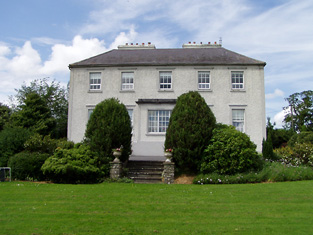
|
| Duane Ville | The residence of Alexander O'Grady Rose, held by him in fee at the time of Griffith's Valuation when it was valued at £7. It is no longer extant. | |
| Duarrigle Castle | Originally a tower house of the O'Keeffe family, leased by Henry Wrixon to Thomas Holmes Justice who built a 'mock' castle in the early 19th century. Inherited by his son Thomas Holmes Justice medical doctor of Mallow. Sold in the Encumbered Estates' Court in 1851 and bought by Henry Chinnery Justice, who left it to his sister Mrs Wallis when he died in 1859. The castle is now a ruin but the gatelodge is occupied. |
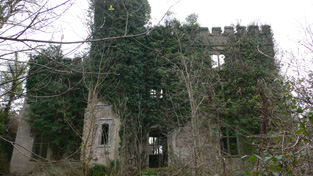
|
| Duckspool or Clashnalachan | At the time of Griffith's Valuation, George Boate was leasing Duckspool to P.C. Howley, when it was valued at £29. Lewis refers to it as the seat of J.M. Galwey in 1837. In 1786 Wilson notes it as the seat of Mr. Boate. On the 25-inch map of the 1890s it is labelled Clashnalachan. In 1906 it was the property of Charles Nugent Humble and valued at £11. A house is still extant at the site. | |
| Dunamon | A tower house with 18th and 19th century additions, In 1786 Wilson refers to Dunamon, the seat of Mr. Caulfeild, as "a fine old castle". Occupied by John Shiel, leasing from the Caulfeild estate at the time of Griffith's Valution, when it was valued at £35. In 1894 Slater refers to it as a residence of St.Geroge Francis Caulfeild. Bought by the Divine Word Missionaries from the Land Commission in 1939 and now in use as a care centre. |

|
| Dunbarry | This house was the home of James Carey in 1814. Occupied by James Heffernan and held from Sir Edward Tierney at the time of Griffith's Valuation, valued at £18. Sold by the Heffernans in the early 20th century, this house is still extant. The Irish Tourist Association survey mentions Dunbarry as the residence of Denis Kiely in the 1940s. | |
| Dunbeacon House | Richard Townsend held this property in fee at the time of Griffith's Valuation, when it was valued at £11 5s. In 1906 it was also the property of Richard Townsend and valued at £8. | |
| Dunboy Castle | Noted by Lewis as the residence of J.L. Puxley in 1837 and held in fee by him in 1852, when the property was valued at £50. In 1894 Slater refers to it as the residence of R. O'Brien Studdert who had married, as his second wife, Maria Puxley. In 1906 the mansion was the property of Henry L. Puxley and valued at £85. The original house was built in several stages, the most recent in the 1860s, close to the ruins of the old O'Sullivan castle, the site of the siege of Dunboy in 1602. The Puxley mansion was burnt in June 1921 during the War of Independence and remained a ruin until the early years of this century. Restoration work has taken place with the intention of converting the house to a hotel but this has not yet reached completion. |

|
| Duncarbry Lodge | At the time of Griffith's Valuation John R. Dickson was the owner of two properties at Duncarbry, barony of Rossinver, one valued at £18 and the other at £10. Lewis records that Rev. Dickson was residing at Duncarbry Lodge in 1837. |

|
| Dundanion Castle | The residence of the architect Sir Thomas Deane in 1837, valued at £78 in the early 1850s and held from Richard Sampson. Sold by Sir Thomas to William Wise in 1860 and by Wise to William Thornton in 1868. A residence is still extant at this site. | |
| Dundermot | A Blakeney property, built circa 1750.Taylor and Skinner note is as occupied by Owens esquire in 1778. In 1786, Wilson refers to it as the seat of Samuel Owens Lee. It was the residence of Richard Kelly in 1814 and held by Patrick O'Connor at the time of Griffith's Valuation when the house was valued at £36. In the 1890s it became the home of the Blake-Kellys, although Nicholas O'Conor is recorded as the occupier in the valuation lists for 1906. Still extant and restored in the early 21st century. |

|
| Dunderrow House | The building at this site is recorded as a Glebe house on the 1st edition Ordnance Survey Map.A different building at the site is labelled as Dunderrow House on the 25-inch edition of the 1890s. John C. Kearney was leasing this property to Blayney Calnane at the time of Griffith's Valuation, when it was valued at £8. There is still an extant house at the site. Lewis refers to "Dunderrow Cottage" as the seat of Rev. R. Halburd in 1837 but this is a different property in the townland of Horse Hill Beg. Local sources also suggest that Thomas Adderley lived "at Dunderrow" before moving to a house in the centre of Inishannon village. In 1786, Wilson writes that Thomas Adderley had a seat at Inishannon. |
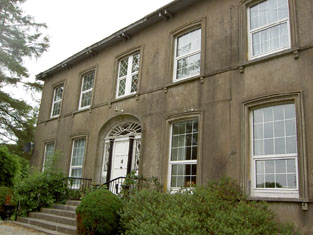
|
| Dundrum | Dundrum was the seat of the Viscounts Hawarden in county Tipperary in the 18th and 19th centuries. The Ordnance Survey Name Books mention that the demesne was well-planted in 1840. Dundrum was held in fee by Viscount Hawarden and valued at £85 at the time of Griffith's Valuation. The Earl de Montalt was still resident in 1906 when the house was valued at £85. The Irish Tourist Association Survey states that it was bought from the Land Commission in 1908 and became St Michael's Presentation Convent. This early 18th century Palladian house now functions as a hotel located in the grounds of the Tipperary golf club. |

|
| Dundullerick | This house was occupied by Edmund Barry in the mid 19th century, when it was valued at £16+ and held in fee. Edmond married in 1836 Sarah Isabella daughter of Pierce Creagh of Rockforest Lodge. Their grandson sold Dundullerick to his cousin James William Creagh who took the additional name of Barry. This house appears to have remained in Creagh Barry possession until the 20th century. \in 1906 valued at £19.10 shillings and occupied by Pierce Barry. | |
| Dundullerick House | Occupied by J[ames] Barry in 1837 and by his son William Barry in the early 1850s. The property was held in fee with 353 acres and the buildings were valued at £26+. William's nephew James William Creagh Barry later purchased Dundullerick. | |
| Dungillick House | Dungillick House, the home of a branch of the Anketell family from at least the mid-18th century, is named on the 1st edition 6 inch Ordnance Survey Map (1836). The Ordnance Survey Field Name Book records the house as thatched. In the mid-19th century Matthew J. Anketell was recorded as the occupant. He held the property from Lord Cremorne. The buildings were valued at £20. Occupied by the Burgess family at the beginning of the 20th century. Dungillick was bought by the Land Commission in 1932 and the house was purchased by James McKenna in 1935. This house remains a family residence. |

|
| Dungummin House | Dungummin House with a very small demesne is named on the first edition six inch Ordnance Survey map (publ. 1837). In 1814 Leet records John Ingham of Dungimmon, Mount Nugent. Joseph Lynch was the occupier recorded in Griffith’s Valuation. He held the property, described as a herd’s house and valued at £12.10.0., from Thomas Whitney. Michael Palles Lynch of Dungimon, county Cavan and of Coola, county Westmeath, sixth son of Joseph Lynch of Roebuck House, county Cavan, is recorded in Walford’s 1910. | |
| Dunhill Lodge | John Power was leasing this property from the Palliser estate in 1850 when it was valued at £19. Leet's directory (1814) and early nineteenth century will records (1834) show it was the residence of William Power. There is still an extant house at the site. | |
| Dunhill Lodge | ||
| Duniry A | Patrick Kennedy was leasing houses and other buildings valued at £8 from Peter Blake at Duniry at the time of Griffith's Valuation. A farm still exists at the site. | |
| Duniry B | Michael Derwin was leasing property valued at £7, including a mill, from Peter Blake at the time of Griffith's Valuation. A house still exists at the site. | |
| Dunkeeran Cottage | Matthew B. Hornibrook was leasing this property to Thomas Hornibrook at the time of Griffith's Valuation, when it was valued at £10. The house is still extant and occupied. |

|
| Dunkerron House | Lewis records that Dr. Taylor was occupying a property adjacent to the ruined castle at Dunkerron in 1837. In 1814, Leet refers to Dunkerrin Castle as the seat of George Cashell. At the time of Griffith’s Valuation, Joseph Taylor was leasing a property there valued at £16 15s from Deane Freeman. Bary states that Joseph Taylor was an agent for the Landsdowne estate. The Taylor property then passed to Dr. Thomas Taylor who built Dunkerron House. In 1906 this was the property of Sir John C. Columb and valued at £22. The property is still extant but extensive housing development has taken place in the demesne. | |
| Dunkettle | Seat of the Morris family from the late 18th century, occupied by Abraham Morris in 1814 and 1837. Wilson, writing in 1786, provides a detailed description of the demesne. At the time of Griffith's Valuation Jonas Morris held the property from George Newenham. The buildings were valued at £60. Bence Jones writes that this house was built on or close to the site of a previous house belonging to the Trant family. The house was sold in the late 19th century to the Gubbins family. |

|
| Dunlewy House | At the time of Griffiths Valuation, Jane Russell was occupying this property which had a valued of over £22. The National Inventory of Architectural Heritage suggests it was built in the mid-nineteenth century but extending an earlier property on the site. It is still extant and in use. |

|
| Dunlewy House | Dunlewy House was held in fee by Jane Russell at the time of Griffiths Valuation when it was valued at over £22. In 1837 Lewis recorded it as the seat of James [Dombrane]. In 1906 it was owned by Ellen Lingard Monk and valued at £64. It is still extant A smaller and earlier Dunlewy House was located some distance south of the current house at B918186. |

|
| Dunloe Castle | At the time of Griffith's Valuation, Daniel Mahony was leasing Dunloe Castle from Thomas H. Broderick when it was valued at £15. Lewis describes it as formerly the seat of the O’Sullivan family but in 1837 the residence of D. Mahony. Leet refers to it as the residence of Daniel Mahony in 1814. Wilson, writing in 1786, mentions Dunloe Castle as the seat of Gustavus Crosbie. In 1894 Slater refers to it as the seat of John Mahony. The Irish Tourist Association surveyor notes that this property has associations with the United Irishmen and states that, in the early 1940s, it was owned by Agnes Petitt. Bary states that it remained in the Mahony family until the mid-20th century. The castle itself is now a ruin, located in the grounds of the Dunloe Castle Hotel. | |
| Dunmore (Gaultiere) | In 1848, James Archer was leasing this property from Lord Waterford's estate when it was valued at £21. It is still extant. | |
| Dunmore Castle | A tower house occupied by the Ouseley family from the late 17th century. In ruins by the late 19th century. |

|
| Dunmore House | William D. Griffith, brother of Richard Griffith of ''Valuation'' fame, was agent to Sir George Shee in the mid 19th century and lived at Dunmore House. In 1894 Slater refers to Dunmore House as the seat of Captain Robert W. Martin. A fine ruin situated on the edge of the golf course. |

|
| Dunmore House (Raphoe North) | This property was held in fee by Robert McClintock at the time of Griffiths Valuation in the 1850s, when it was valued at £38. In 1837 Lewis referred to it as the seat of R. McClintock. By 1906 it was owned by his representatives with the same valuation. The National Inventory of Architectural Heritage suggests it was built in the 1740s with extensions in the 1820s and 1840s. It is still extant and occupied. |
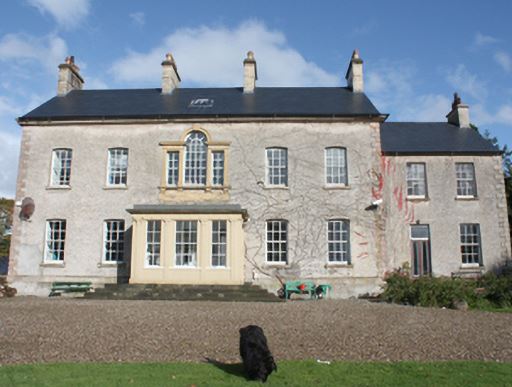
|
| Dunmore Lodge | Melvin states that the Dunmore estate had been inherited by the Gores in the early eighteenth century and that Ralph Gore resided at Dunmore during that century. His mansion was subsequently in use as a barracks until it was destroyed during the Civil War in the early twentieth century. Marked on the Taylor and Skinner map of 1778 as the residence of the Earl of Ross and also noted as "the fine seat of the Earl of Ross" by Wilson in 1786. In 1814 Leet noted "Dunmore Lodge" as the residence of John Egan. | |
| Dunmuckrum | At the time of Griffiths Valuation, David Stewart, senior, was leasing a property valued at £10 from the Conolly estate. | |
| Dunnaman | Matthew O'Flaherty held buildings valued at £13+ and 219 acres from James D. Lyons at the time of Griffith's Valuation. Grid Reference is approximate. | |
| Dunnamark House | Leased by Alicia Tisdall from Samuel Hutchins at the time of Griffith's Valuation, when it was valued at £8 5s. In the 1940s the Irish Tourist Association survey noted that it was the residence of Dr. Nunan. There is still an extant house at the site. | |
| Dunnamark Mill | Michael Murphy was leasing this property, including a mill, from the Kenmare estate in 1852, when it was valued at £35. The building is labelled Barytes Mill on the 25-inch Ordnance Survey map of the 1890s. It is now a ruin. | |
| Dunowen | Dunowen House was being leased jointly by the Bandon and Smith-Barry estates to George Sandes at the time of Griffith's Valuation, when it was valued at £19. In 2009 it was offered for sale. |

|
| Dunraymond | This house with extensive outbuildings and walled garden is named on the 1st edition 6 inch Ordnance Survey Map (1836). Documents in PRONI (D991/1/A/3) record the interest of the Bartley family of nearby Bartley’s Grove in Dunraymond in the early 19th century. Described in the Ordnance Survey Field Name Book as having ‘been greatly improved of late both as to additions being made to the buildings and the formation of plantings’. By the time of Griffith’s Valuation David Ross was resident. He held the property from Newell Atkinson. The buildings were valued at £34. A large complex of farm buildings is now located at this site. | |
| Dunsandle | A large house built in the later 18th century for Denis Daly, M.P. Wilson refers to it in 1786 as "the most magnificent and beautiful seat, with ample demesnes". It was held in fee by Lord Dunsandle at the time of Griffith's Valuation, when it was valued at £70. In 1894 Slater refers to it as the seat of William Daly. Dunsandle House was sold in 1954 and demolished in 1958 although portions of the walls are still standing. Evidence of both the stable yard and walled garden still exists also. |
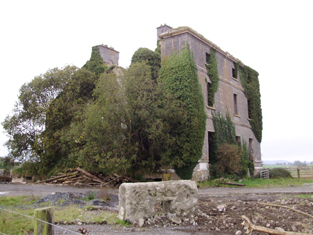
|
| Dunsfort | Occupied by Richard Adams in 1814 and by Laurence Smithwick at the time of Griffith's Valuation when valued at £20 and held from the representatives of Viscount Midleton. Only the farm buildings appear to be shown on the 25-inch map of the 1890s. | |
| Dunworley Cottage | William Hawke was leasing this property from Joseph Bennett at the time of Griffith's Valuation, when it was valued at £7 5s. It is still extant. | |
| Durham Lodge | Elizabeth Sandys advertised for sale "Durham Lodge" and 39 acres in July 1854. The Sandys house was valued at £3 in the 1850s and in 1906. This house was held in fee by William "Sands" at the time of Griffith's Valuation. It is not named on the 1st edition Ordnance Survey map but is shown as Durham Lodge on subsequent editions. A farm is still extant at the site. | |
| Durrow | In 1786 Wilson refers to "Durra" as a seat of Mr. Bagot. At the time of Griffith's Valuation, Francis Hurley was leasing a property valued at £7 together with over 100 acres, from the Bagot estate at Durrow, barony of Ballymoe. A house is still extant at the site. |
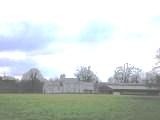
|
| Durrus Glebe | Rev. James Freke was leasing this property from the Ecclesiastical Commissioners at the time of Griffith's Valuation when it was valued at £20. Lewis records it as the residence of Rev. Alcock in 1837. The house is still extant and occupied. |
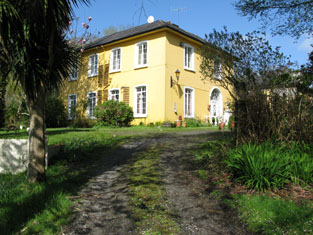
|
| Dysert | A house valued at £12 and held by Nicholas P. Leader in fee at the time of Griffith's Valuation. This house was still in Leader occupation in 1906. A house and farm are still extant at the site. | |
| Dysert (Ardmore) | Rev. Ambrose Power was leasing a property from the O'Dell estate in 1851 which was valued at £12. | |
| E.T.M. Ville | E.T.M. Ville, Clonmel was occupied by E.T.M. Butler [Edmond Theobald Mandeville Butler] in 1814 and by his widow Mrs Eliza Butler in the mid 19th century. The house was then valued at £13 and held from the Putland/Hulse estate. Some buildings remain at the site. | |
| Eagle Hill | Eagle Hill was leased from Andrew Martin by Henry Pigott at the time of Griffith's Valuation when it was valued at £20. In 1837 Lewis recorded Eagle Hill as the seat of Capt. H. Pigot. It was recorded as the residence of A.P. Martin in 1814. In 1906 Anne Martin was the owner when the buildings were valued at almost £16. It is still extant and occupied. |
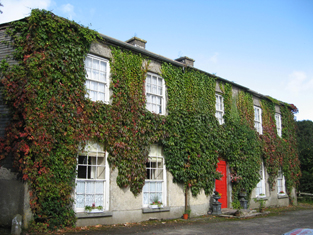
|
| Earlsfield | Earlsfield had earlier been a Dodwell property. At the time of Griffith's Valuation it was leased from the Gore-Booth estate by Capt. Richard Gethin and was valued at £20. Slater records it as the seat of Francis Gethin in 1894. It is still extant and has served as a convent for many years. |

|
| Earlstown | In 1786 Wilson refers to "Capasell" s the seat of Mr. Devenish [?]. The house at this location is labelled Earlstown on the 1st edition Ordnance Survey map. In 1846 Slater refers to Robert Grace resident at Earlston. Robert Eyre was leasing a property in the townland of Cappasallagh, parish of Kilmalinogue, barony of Longford, valued at £11 from the Clanricarde estate in 1856. There are still occupied buildings at this site, the focus of a large farming enterprise. |

|
| Earlsvale | A house built circa 1840s on the estate of Earl Annesley and occupied by Captain Francis Meik at the time of Griffith’s Valuation, when the buildings were valued at £18. This may have been the residence of the agent of Earl Annesley. | |
| East Grove | Bence Jones writes that this early 19th century house was built by Dorcas Bousfield, daughter of William Bagwell and his wife Jane Harper. After her death it was inherited by the Bagwells and remained in their possession until the mid 20th century. In 1837 John Bagwell is recorded as the proprietor of East Grove and also in the early 1850s, when the property was valued at £40 and held from the representatives of Viscount Midleton. In 1942 the Irish Tourist Association Survey noted that it was the residence of Major Bagwell and the adjacent grounds contained the remains of buildings thought to be "the now-unknown castle of Ballinakilla". 20th century owners included Lorretta Brennan Glucksman, and the Kelly family, musicians. In recent years it has been offered for sale. |

|
| Eastly Cottage | This house was the home of Mary Anne Lombard in the mid 19th century. She held the property from the Earl of Listowel and it was valued at £20. Hajba writes that the kennels for the Duhallow Foxhounds were later located close to the cottage. Derelict for a number of years the building has been restored and was functioning as a pub in the early 21st century. | |
| Easton House | In 1851 Jane Smyth was leasing this property from the Bishop of Cork's estate when it was valued at £13 15s. | |
| Eastwell | In 1837 Lewis records Eastwell as the seat of C. Usher. At the time of Griffith's Valuation it was occupied by Christopher Usher and the buildings were valued at £79. By 1906 it was in the ownership of William A. Usher and was valued at £81. This house is no longer extant but extensive remains of stables, demesne and walled garden survive. |
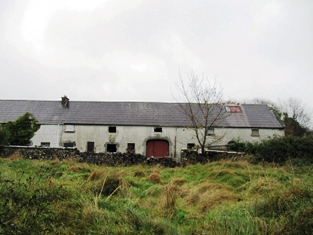
|
| Eastwood | Lewis records Thomas Bennett as the proprietor of Eastwood. James Mason held Eastwood House and 209 acres from Thomas Bennett at the time of Griffith's Valuation. The buildings were valued at £22+. Buildings are still located at this site. | |
| Ebor Hall | A house built before Griffith's Valuation by Deputy Commissary General Booth on land leased from the Provost and Fellows of Trinity College, Dublin. Booth later sold his interest to Lord Mountmorres who was murdered nearby in 1880. In 1885 Walford refers to it as the seat of Joseph Skerrett Blake. It belonged to the Boyd family for much of the 20th century. Extensively renovated in the late 20th century, it is now a well maintained residence on the shore of Lough Corrib. |

|
| Eden Hill | Situated on the Longfield estate and occupied by John Crosbie who held the house valued at £19.10 shillings from Joseph Carpenter. The Carpenter resided here from the late 18th century. Thomas Carmichael bought Carpenter's interest and advertised the sale of Eden Hill house and demesne in December 1856. Later the home of the Guerin family and in the late 20th century of the O'Callaghan family. |

|
| Eden House | Eden House was built later in the nineteenth century. In the 1870s it was recorded as the residence of Galbraith Hamilton. A will and probate grant in the Public Record Office of Northern Ireland refers to George Hamilton of Eden in 1862. It is still extant and occupied. | |
| Eden Park | Occupied by Joseph Brown at the time of Griffith's Valuation, when the property was valued at £3. Brown was leasing from Francis O'Malley. Mulloy writes that nothing remains of the house. | |
| Eden Vale | William Stacpoole moved from Annagh to Eden Vale in 1776 and this house continued to be the main Stacpoole residence until it was sold to the Clare Board of Health in the 1920s. In 1786 Wilson refers to it as the seat of William Stacpoole. At the time of Griffith's Valuation it was occupied by Richard J. Stacpoole and valued at £50. The house was a tuberculosis sanatorium in the 1940s. It is still extant. |

|
| Edenmore House | John Cochrane was holding this property in fee at the time of Griffiths Valuation when it was valued at £28. In 1906 it was also owned by John Cochrane and valued at £26. The National Inventory of Architectural Heritage suggests it was built c.1790 and offers a detailed outline of its occupancy. It is still extant. |
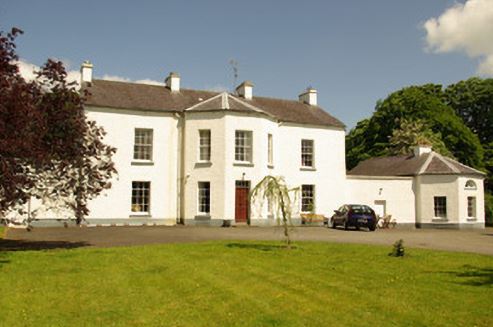
|
| Edgecliff House | James K. Jenkins was leasing this property from Lord Kingsale's estate at the time of Griffith's Valuation, when it was valued at £7 5s. It is labelled Edgecliff House on the 25-inch Ordnance Map published in the 1890s. This house no longer exists. | |
| Edmondstown | In 1786 Wilson refers to Edmondstown as "the fine seat of Mr. Costello". At the time of Griffith's Valuation the original house was occupied by Charles Costello. Another house was built in 1864 and it is now the home of the Bishop of Achonry and is situated in county Roscommon. |

|
| Edward's Lodge | The 1st edition OS map shows a house called Edward's Lodge, at Derrylahan, barony of Leitrim, county Galway. This appears to be the property, valued at over £1, leased by the Aylward estate to Patrick Mohan at the time of Griffith's Valuation. There are not buildings at the site now and the area is heavily forested. | |
| Edwardstown | Edwardstown was the residence of John Russell in the early 1850s held by him in fee and the buildings were valued at £18+. |

|
| Egmont Cottage | Egmont Cottage is marked on the first Ordnance Survey map circa 1840. It was the single storied residence of Margaret Magrath in the early 1850s. She held the property from the Earl of Egmont and the buildings were valued at £10. The building has since been extended and is still occupied. Hajba calls this house Egmont Lodge. |

|
| Egmont House | An early Perceval house situated at Egmont was replaced by the present house in the 18th century. At the time of Griffith's Valuation John Bolster was occupying Egmont House on the Egmont estate. The buildings were valued at £15. Later leased to the Lynch family. The house is extant and under refurbishment in recent years. |

|
| Egmont Lodge | A house was in existence at this location at the time of the first Ordnance Survey but is not named on the map. By the time of Griffith's Valuation it was valued at £14 and occupied by Bartholomew W. Purdon. It is labelled Egmont Lodge on the 25-inch Ordnance Survey map of the 1890s. A house is still extant at the site. |

|
| Egmont Villa | A house occupied by Neptune Blood in the mid 19th century. He held the house valued at £19 from Sir Edward Tierney. Restored in the 1980s by Patrick Callaghan and still extant. | |
| Eighter | On the first edition six inch Ordnance Survey map (publ. 1837) Eighter House, part of the estate of the Marquess of Headfort, is shown as set in a small demesne close to the shore of Lough Ramor. Henry Sargent was the occupier in the mid-19th century when the buildings were valued at £16. In the 1870s Eighter was the home of John Alexander Johnston, who owned 111 acres in the county in 1876. He was medical doctor and his wife had a connection with the Sargent family. Home of Michael M’Enroe in the 1920s. It appears to be extant. References to Eighter in the Small Private Collections of Cavan Library's Archives Service, P017/0084, P017/0104, P017/0125 & P017/0166. | |
| Eldon Lodge | Robert Corscadden's address is given as Eldon Lodge, Manorhamilton, in 1878. | |
| Elgin Cottage | In 1851 this property was leased by Georgiana Gumbleton to Edmund Barry when it was valued at £10. It was built after the 1st edition Ordnance map and is labelled Elgin Cottage on the 25-inch edition of the 1890s. There is still an extant house at the site. | |
| Ellaghmore | Occupied by Edmund Howley in 1814 and by E. Howley in the 1830s. A house valued at £2.10 shillings was occupied by Bartholomew Higgins at the time of Griffith's Valuation. It is no longer extant. | |
| Ellen Ville | This appears to be the house known as Broomhill which was a Radley residence. The house is named Ellen Ville on the first Ordnance Survey map. At the time of Griffith's Valuation Dr Thomas Godfrey was occupying Ellen Ville, valued at £14.15 shillings and held from William Furlong. | |
| Ellenville or Ardaghowen | The first edition OS Map suggests the house on this site was known at that time as Ellenville. It is now known as Ardaghown, still extant but derelict and was under renovation in 2006. McTernan indicates that it was originally built as a dower house for the Wynne estate. In the 1850s it was held by Owen Wynne from Capt. James Martin and valued at £35. |

|
| Ellesmere | Harloe Powell was leasing a house valued at £18 at Ardcarn, barony of Boyle, from Viscount Lorton's estate, at the time of Griffith's Valuation. This house is still extant and occupied. |

|
| Ellistron Castle | A Browne castle, a house is marked close by as the residence of the Brownes in the 1770s. In 1786 Wilson refers to Ellistron as the seat of Mr. Browne. However there is no house at this location on the 1838 Ordnance Survey map but an avenue is shown there. | |
| Elm Hall | Lewis records Elm Hall as the residence of Peter Burke while the Ordnance Survey Name Books refer to it as that of "Counsellor Burke". By the time of Griffith's Valuation his son Joseph Burke was the occupier, holding the property in fee, the house was valued at £10. A farm building now occupies the site of Elm Hall. |
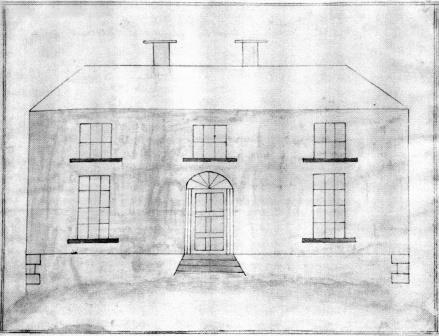
|
| Elm Hill | An 18th century house the home of a branch of the Studdert family held from Lord Southwell. Occupied by Ion Studdert in the mid 19th century when the buildings were valued at £27. It was advertised for sale in June 1855 when it contained a "spacious and lofty parlour, drawing room and hall; nine capital bedrooms..". A lithograph of the house is included with the rental. In 1906 this house, valued at £16, was occupied by the representative of Thomas Magner. In the later twenteth century owned by the Woulfe family and now derelict. |
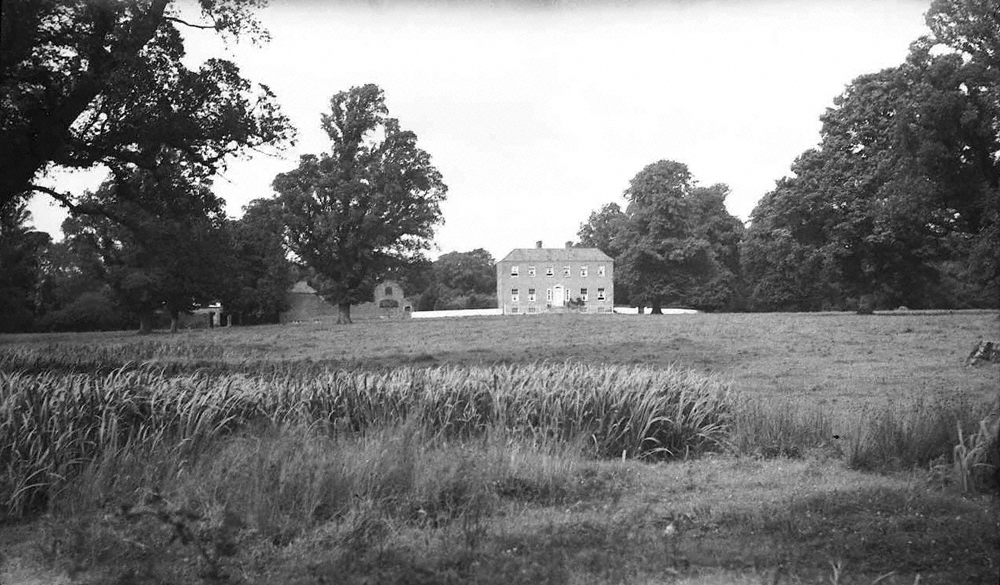
|
| Elm Hill House | A home of the Bourchier family in the 18th century. The Bourchiers intermarried with the Massys. The house was located on the Massy estate. Mrs Davis was resident at Elm Hill in 1837 and Joseph Wallplate in the mid 1850s when the house was valued at £12. The home of the Heffernan family in the latter part of the 19th century. The house is still occupied. | |
| Elm Hill House | The Ordnance Survey Name Books record William Middleton as the occupier of Elm Hill House in 1839 and mention the surroundings as "a very pretty demesne situated in a beautiful locality". At the time of Griffith's Valuation, William Middleton was leasing this property from the Poe estate when the house was valued at almost £8. The original house is no longer extant and a modern house has been constructed at the site. | |
| Elm Park | The records suggest that this house was built post 1814 and pre 1837 though there may have been an earlier property as Wilson refers to "Elm" as the seat of General Massey in 1786. Bence Jones writes that it was an early 19th century house. It was the home of the Massey family, Barons Clarina, in the 19th century. The buildings were valued at £90 at the time of Griffith's Valuation and in 1906. Bought by Patrick King in 1925 and home of the King family until 1956, now demolished. |

|
| Elm Park | Garyhasty was described by Smith in 1750 as the "pleasant country house" of Mr Riggs Faulkner. I A house located on the Riggs Falkiner estate, Wilson notes it as the seat of Rev. Mr. Kenney in 1786. It was occupied by Valentine Barry in 1837 and by Thomas Barry at the time of Griffith's Valuation and valued at £36. Home of Richard Ashe Orpen in the 1870s. Elm Park is still extant and occupied. |
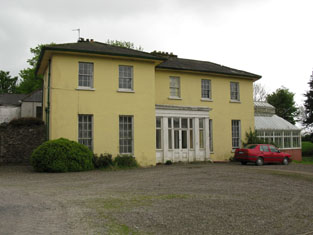
|
| Elmglyn | Elmglyn was the residence of T. Gollock in 1837 and of Patrick Daly at the time of Griffith's Valuation. He held the property from the representatives of Thomas Gollock and the buildings were valued at £11. The original house is not extant. | |
| Elmhall | Built by Gerald Cuff early in the 18th century, it was let to the Jordans of Murrisk in the 1770s and to a branch of the Browne family of Westport from the 1780s until the early 19th century. In 1786 Wilson refers to it as a seat of the Rt.Hon. James Cuffe. In 1837 the 1st edition Ordnance Survey map notes that it was 'in ruins'. The Irish Tourist Association File states that Elmhall is said to have been burnt in 1798. Only some fragments of walls remain at the site. |
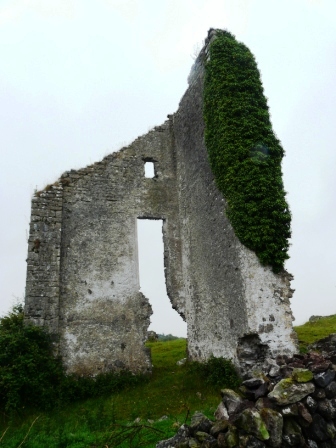
|
| Elmhill | Occupied by Edward Rochfort in 1814. By the time of Griffith's Valuation there was no house with a valuation of more than £1.18 shillings in the townland. The 25-inch map of the 1890s shows a later building called Elmhill House slightly north of the original building. There is still an extant house at the site. |
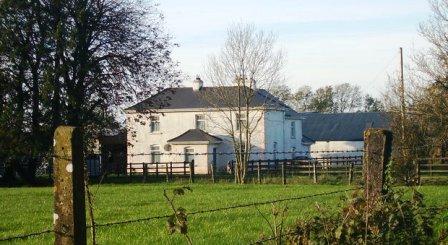
|
| Elmvale | Originally an O'Hogan home which passed to the O'Briens through the marriage of Eleanor O'Hogan and Turlough O'Brien. Their son married Margaret Long. She married secondly Cornelius O'Brien of Birchfield. At the time of Griffith's Valuation the house valued at £15 was occupied by John O'Brien who held it from Sir Lucius O'Brien. Weir writes that the house was demolished circa 1965. In 1778 and 1786 this house, known as Cross, was occupied by a Lysaght. | |
| Elmvale | Elmvale was occupied in 1814 by Henry Lysaght and by 1837 was in the occupation of J. Duggan. Arthur Duggan held the property from the Earl of Limerick in the early 1850s. The house was valued at £20. Hajba writes that in the early 20th century the house was purchased by Sidney Royse Lysaght and following a feud with a neighbour was burnt in 1917. Later rebuilt and still occupied. |

|
| Elsinore | At the time of Griffith's Valuation, Edward Cooper owned a property at Rosses Upper, barony of Carbury, valued at £16. In 1906 the representatives of William Middleton held a property here valued at £18 as well as over 350 acres of untenanted land. The property also has associations with W.B. Yeats who used to spend holidays here with the Middleton family. The house is now a ruin. |

|
| Elton | In 1786 Wilson notes Elton as the seat of Mr.Grady. Leet records the Reverend Thomas Grady [of Cappercullen] as the occupier of Elton in 1814. Mrs Grady lived at Elton in 1837 and Mrs Mary Jane Grady was resident at the time of Griffith's Valuation. She held the property in fee. The buildings were valued at £34. Described in the rental of 1853 as having a "cheerful and commanding aspect". The tenant from year to year was John Simms. In the later part of the 19th century this house belonged to the Bevans of Camas. The original house is not extant. | |
| Elysium | This house is marked on the first edition Ordnance Survey map and was inhabited by Thomas Ely in 1837. Thomas Ely held the property in fee at the time of Griffith's Valuation when the house was valued at £23. The Elys were still resident in the 1870s. George Evans was occupying this house in 1906. There is still a house located at this site. | |
| Emlagh | Robert Irwin was leasing a property valued at £5 + 230 acres at Emlagh, barony of Castlerea, to Patrick Flynn, at the time of Griffith's Valuation. The Census of Elphin indicates that John Irwin resided there in 1749. Gormley states that the house was probably built around 1740 and extended in the early 1800s. By the 1880s the Irwins had sold Emlagh to Walter McDermott. The house was later demolished. | |
| Emlaghkeadew | At the time of Griffith's Valuation this house was ccupied by Louis Ormsby when it was valued at almost £10. It is no longer extant and a modern house exists at the site now. | |
| Emlaghmore House | Thomas Smith was leasing this property from the Lansdowne estate at the time of Griffith's Valuation, when it was valued at £12 10s. Bary states that this house was associated with a branch of the O'Connell family, one of whom, Mary, married Daniel O'Connell. It later fell into ruin and nothing remains today. | |
| Emlaghmore Lodge | Michael Fitzgerald held a herd's house and offices, valued at £7.17 shillings from John Boswell in the townland of Emlaghmore at the time of Griffith's Valuation. Emlaghmore Lodge, formerly known as Emlaghmore House, was erected however in the early 1860s, probably by William Young. Bought by the Tinne family in 1924 and used as a holiday home until the 1960s when it became their permanent home. Emlaghmore Lodge now functions as a guest house run by the Tinne family see http://www.emlaghmore.com/ |
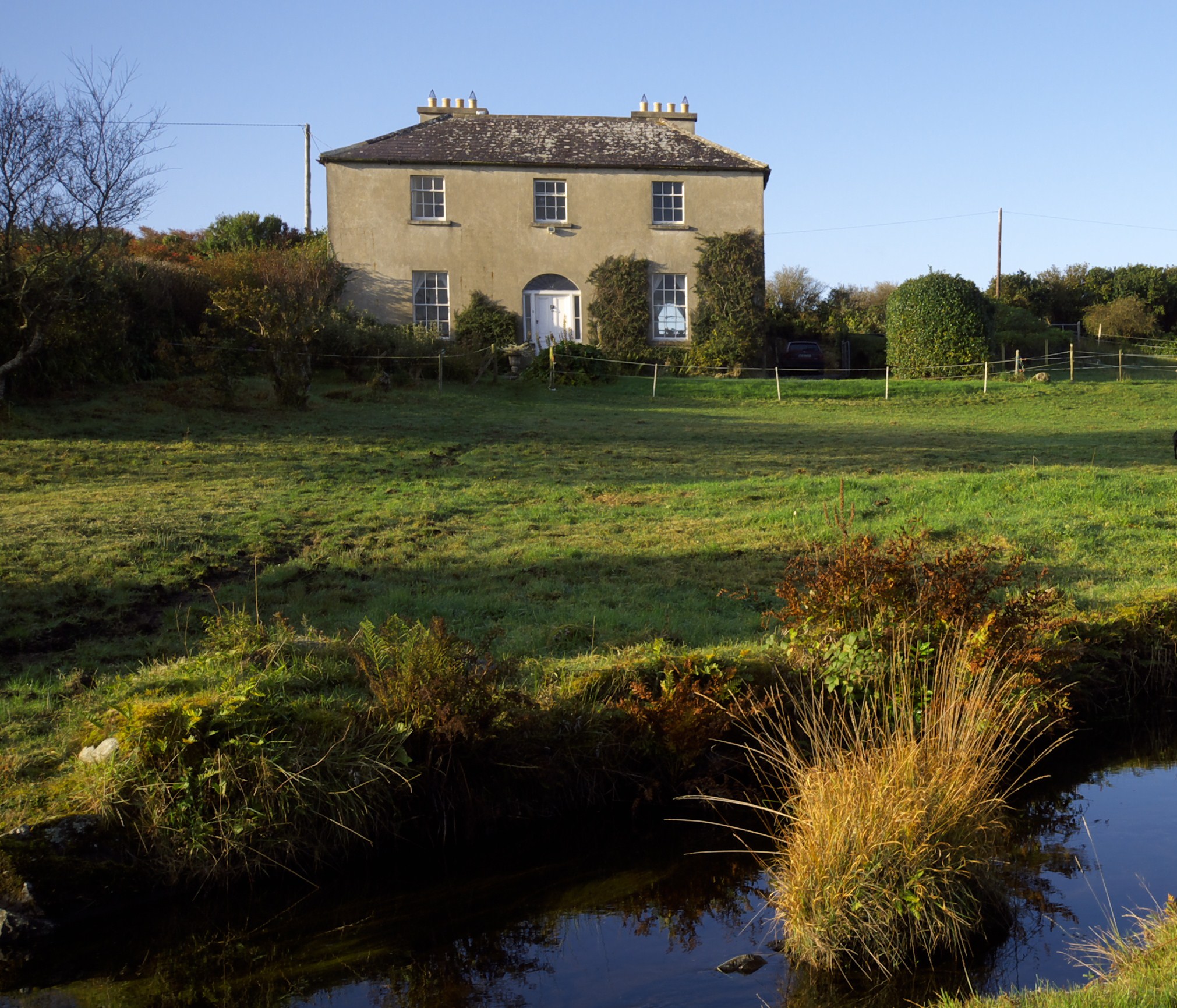
|
| Emlaghroyin | Built circa 1770, occupied by McDermot esquire in 1778 and also noted as the residence of Thomas McDermott by Wilson in 1786. The seat of Oliver Armstrong at the time of Griffith's Valuation, held from St George Caulfeild and valued at £30. This house is still extant. |

|
| Enfield | Alfred Busby was occuping the house at Enfield, then valued at £24, at the time of Griffith's Valuation. In 1814 it was the residence of Mrs. Birch. Lewis records it as the seat of P. O'Connor in 1837. In 1749 the Census of Elphin recorded Edmund Kelly as resident at Enfield. | |
| Englishtown (Ballygalda House) | A Mitchell family home from the mid 18th century. Occupied by William N. Reynolds at the time of Griffith's Valuation who held from George G. Battersby. The house was valued at £4.It is labelled Englishtown on the 1st edtion Ordnance Survey map but as Ballygalda House on the later 25-inch edition. A house and substantial farm are still extant at the site. |

